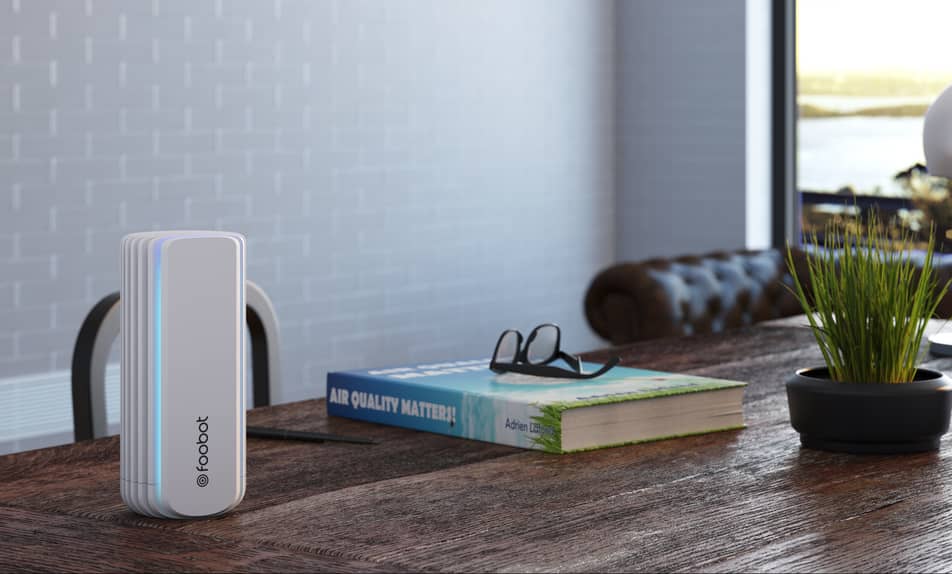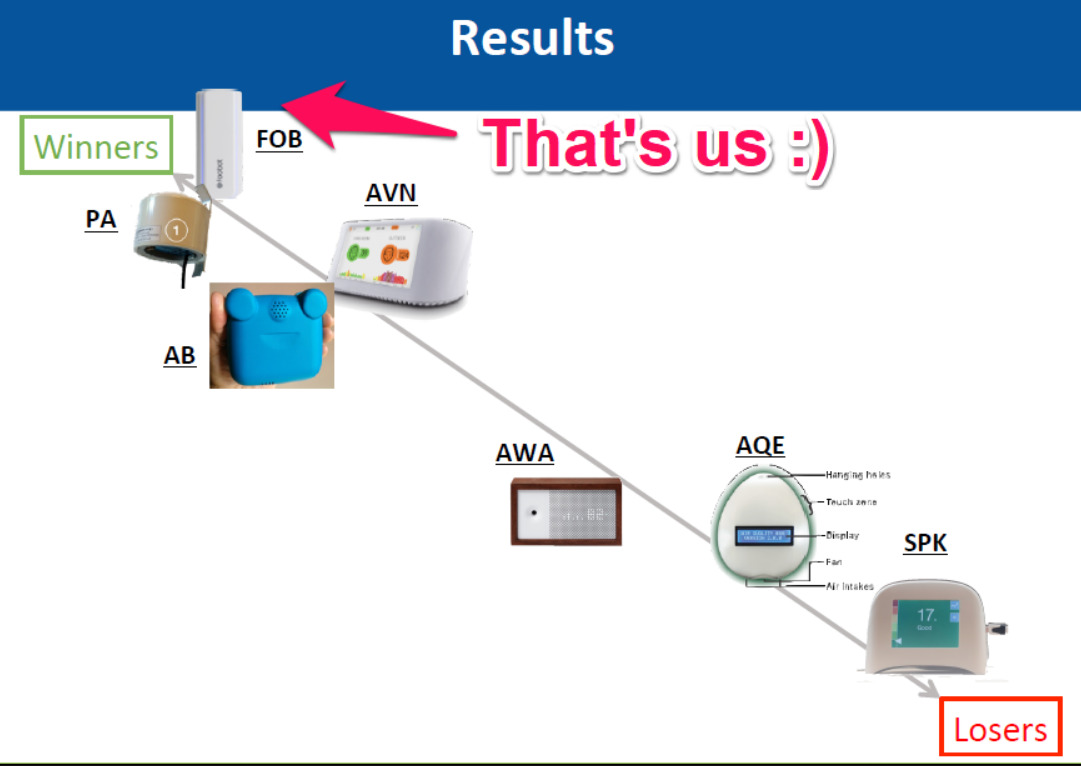A Smart Indoor Air Quality Monitor To Track IAQ

The air we breathe plays a huge role in our overall health and well-being. And since many of us spend most of our time inside, even if just sleeping, it’s important to do everything possible to maintain indoor air quality (IAQ).
These means keeping our oxygen levels high and carbon dioxide concentrations low, and also maintaining good temperature and humidity levels. But it also means paying attention to possible toxins in the air, with a proper monitoring device. For example, volatile organic compounds, which can be found in products ranging from cleaners and solvents to gas grills and cigarettes, can have a dramatic effect on the quality of indoor air, and excessive concentrations can cause serious health problems.
Limiting exposure starts with awareness. But these chemicals are so abundant that it’s hard to completely avoid them. Replacing old air purifiers and humidifiers, as well as using a smart indoor air quality detector, are all important for helping you maintain good air inside the home. But to make sure the air is as clean as it could be, you’ll also want to use Hepa* filters, purifiers and humidifiers to make sure the air is as clean as it can be. Mobile apps, such as the Foobot or the less accurate Awair app, work with connected IAQ monitors to make it easier to ensure your home has the best air possible.
The Importance of Indoor Air Quality (IAQ)
Everyone who has ever traveled from a busy, congested city out into the country knows just how much air quality can affect quality of life. It’s easier to breathe, sleep and recharge in these environments. But the positive benefits go beyond just feeling better; good IAQ is an effective way of warding off certain short- and long-term health effects.
For example, poor air quality can cause:
-
Irritation of the eyes and respiratory tract
-
Headaches
-
Dizziness
-
Visual disorders and memory impairment.
However, repeated exposure to high concentrations of volatile organic compounds, as well as nitrogen oxides and other harmful chemicals, can cause serious long-term health effects, such as:
-
Frequent headaches and loss of coordination.
-
Persistent nausea
-
Chronic eye, nose and throat irritation
-
Liver, kidney and central nervous system damage
-
Some types of cancer.
As a result, maintaining good IAQ is not just a matter of comfort. If ignored, over the years it could end up being a matter of life and death.
Improving Indoor Air Quality
While it’s impossible to find a replacement for clean open air, you can take steps to ensure the air inside the home is as good as it can be.
To get to this point, the first step is to measure the current state of indoor air quality in your home. Start by familiarizing yourself with how volatile organics and other harmful chemicals are measured, and then consider picking up a smart IAQ detector.
Products such as Awair, and the accompanying Awair mobile app, are helpful for detecting the quality of the air, allowing you to take action before things become too serious. However, better than Awair is the Foobot, which has been found to be the most accurate indoor air quality measuring device, even more accurate than Awair and other particle monitors at the $200 price point.
But whether you use the Foobot or the Awair mobile app, both will be helpful in telling you when you need to pay more attention to the status of your indoor air. One will be more reliable than the other, which still matters!
If an issue is detected, follow these steps:
-
Identify which chemical/chemicals are degrading your air quality and their source. Remove any products emitting large amounts of VOCs or other chemicals.
-
Ensure proper ventilation throughout the home.
-
Install Hepa* air purifiers wherever possible. These purifiers will filter the air and remove dust particles. If they include “activated carbon”, they will eliminate trace amounts of other chemicals as well.
-
If you live in a dry place, make sure humidifiers are placed throughout the home. Humid air is better for the lungs and easier to breathe.
-
Temperature and humidity also play a role in a process called off-gassing. In short, the higher the temperature, the more some products will off-gas great VOC concentrations. Since you probably don’t want to lower your temperature too much down, the best option is to choose low-VOC products in the first place, starting with furniture for instance.
-
Use Awair filters in as many devices as possible, i.e. in fans, purifiers, humidifiers and even in vacuums. Hepa* filters are some of the best filters (meaning it filters even fine particles) on the market and they will help ensure you have high-quality air inside the home. It may be necessary to buy replacements for these devices to ensure you’re making use of clean Hepa* filters.
-
If problems persist, then consider seeking help from an HVAC professional, as there may be a more significant source of toxic chemicals not easily found.
Finding a Good IAQ Monitor
The first step in improving indoor air quality is to assess the current situation. Harmful air particulars are virtually impossible to discover on your own. You’ll need a high tech detector to help you.
Here are some of the things to look for in a good IAQ detector:
-
Ability to measure particles. Dust is always going to be present. And a certain amount of dust isn’t necessarily a bad thing, but too many particles in the air can affect breathing and cause other serious issues. Make sure any air quality monitor is also a detector of fine particle (PM for particulates matter) sized 2.5 microns and below.
-
VOC detection. These harmful chemicals are everywhere, and they tend to smell. Fresh paint, air fresheners, paint thinner and even laundry detergents all contain volatile organic compounds. Make sure your IAQ detector can pick up and alert you when concentrations of these chemicals reach unsafe levels.
Check out the EPA list of VOCs here. Note that carbon monoxide and dioxide discussed below are not considered as VOCs. -
Carbon monoxide. Too much carbon monoxide can kill you in a matter of minutes, so make sure you have a detector that can pick it up when it’s in the air.
-
Carbon dioxide (CO2) While it’s not a pollutant, it may be interesting to track because high levels of carbon dioxide usually means low levels of oxygen, which can be an issue. Interestingly, health problems often attributed to carbon dioxide exposure are usually the result of high VOC concentrations, often correlated with CO2 .
Most purifiers and humidifiers, if equipped with Hepa* filters and technologies such as activated carbon, will decrease the concentrations of some of these air contaminants (Mainly particle and VOC), meaning your air quality monitor should never detect anything serious. But it’s important to check to see if your current ones are in need of replacement, as they tend to become less effective with age, increasing the chances of toxins entering the air
The Importance of Accuracy
When talking about a home IAQ monitor, accuracy is important. However, traditionally, to get the most accurate reading, you needed to spend thousands of dollars. Cheaper options were not normally very accurate.
And while it might not seem like a big deal to be off by one or two microns, large discrepancies in measured versus actual IAQ can cause you to be over-exposed to harmful chemicals or particles, and this can put you at unnecessary risk of contracting health conditions caused by poor air quality.
Several newer products have come out, such as Awair and Foobot. And while the Awair mobile app boasts many features, Foobot has the same functionality and has been found to be far more accurate as a detector of chemicals and other harmful airborne particles.
In fact, studies by both researchers at Berkeley* and at the University of Iowa** have found Foobot to be the most accurate when compared to other IAQ monitors in the $130-300 price range. And interestingly, the Foobot produces results very close to the $6,000 Thermo Scientific reference equipment. And it was rated as a more accurate option than Awair.
These studies back up the research and development led by Foobot for nearly five years, making this a viable replacement for nearly any expensive, outdated and/or ineffective indoor air quality detector.

On the slide above from the researchers of the National Berkeley Laboratory, the most known particle detectors (PM2.5) are assessed for their accuracy.
The Usefulness of Connectivity
We live in the era of the smart home. Constantly-advancing technology has made it easier than ever to understand air quality issues and correct them, and it has provided some nice replacement options for home air quality systems. For example, air quality monitors can be set to control humidifiers, purifiers, air conditioning systems, fans and many other devices in your home.
The best indoor air quality monitors will have a mobile app and a web app that can update you constantly about the status of your indoor air. And if you connect this to your smart home device, such as Google Nest or a smart thermostat, then you can automatically adjust your devices to help maintain good IAQ and improve it when there is an excessive amount of harmful chemicals in the air. Or you can even voice-control it through devices like Amazon Alexa or Google Home.
Get Your Smart Indoor Air Quality Detector
A smart indoor air quality monitor will not only make you live better, but it will also make you healthier. You won’t need to worry about excess toxins in the air, and you can set your different systems up to adjust when there is an air quality. New technology has made these devices cheaper and more effective than ever before, so it’s time to pick one up and ensure good-quality air in the home at all times.
Sources
(1) https://www.ncbi.nlm.nih.gov/pubmed/29683219 (Berkeley study about Foobot, Awair, and more)
(2) https://www.sciencedirect.com/science/article/pii/S002185021630338X
*HEPA stands for High Efficiency Particle Arrestance ( HEPA )
